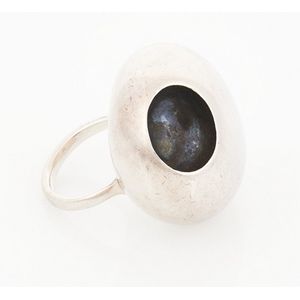Georg Jensen Jacqueline Rabun Cave Ring
Georg Jensen, Jacqueline Rabun cave ring no 414, featuring oxidised concave hollow, set in sterling silver sphere, stamped 'Georg Jensen 925S 441', with original box, 38 grams, size P. Provenance: Property of a country lady, NSW
You must be a subscriber, and be logged in to view price and dealer details.
Subscribe Now to view actual auction price for this item
When you subscribe, you have the option of setting the currency in which to display prices to $Au, $US, $NZ or Stg.
This item has been sold, and the description, image and price are for reference purposes only.
- Oxidised (finish in Jewellery) - An oxidised finish in jewellery, particularly gold, refers to a surface treatment that intentionally darkens or blackens the metal surface to create an antique or vintage look. The process involves using a chemical solution to speed up the natural tarnishing or corrosion of the metal, resulting in a dark, matte or semi-matte finish.
In gold jewellery, oxidised finishes are typically applied to lower karat gold alloys, such as 14k or 18k gold, rather than higher karat gold, such as 22k or 24k gold. This is because lower karat gold alloys contain more base metals, such as copper, which are more reactive and prone to tarnishing.
Oxidised finishes in gold jewellery can create a wide range of looks, from a subtle aged patina to a more dramatic blackened finish, depending on the strength and duration of the chemical treatment. This type of finish can add depth and character to jewellery designs, and is often used to create contrast between different elements or textures in a piece. - Sterling Silver - Sterling silver is a mixture of 92.5% pure silver and 7.5% of another metal, usually copper. Fine silver is 99.9% pure silver, and is relatively soft and the addition of the very small amount of copper gives the metal enough strength and hardness to be worked into jewellery, decorative and household objects.
This item has been included into following indexes:
